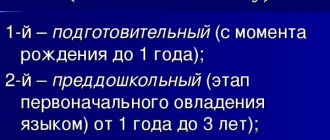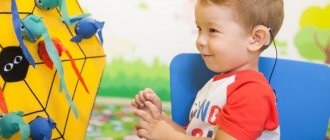Stages of development of a child’s own (expressive) speech:
Screams
- arise from birth.
Booming
– prolonged pronunciation of vowels and syllables with throat consonants (gu, agu, gee) from 2 to 5-7 months.
Against the background of a melodious hum, syllables with labial and anterior lingual sounds appear
, which then transform into babble.
Babbling
– repeated repetition of syllables, with labial and frontal consonants (ma-ma-ma, boo-boo-boo) began from 4-7.5 months.
Words
- the transition is carried out against the background of ongoing babbling: babbling words (mom, dad, bobo, bang, am, give) from 11-12 months.
The appearance of words in the adult lexicon (milk - moko, mami - take, maka - small, titiki - watch) began at 1 year 7/9 months. The coexistence of words, correctly and incorrectly pronounced, is the main pattern of the initial stages of speech development in children.
Growth of a child’s vocabulary from one year and older
- 1 year - 5-9 words
- 1.5 years from 20 to 40 (from different authors)
- 2 years from 50 to 200 words
- 3 years from 800 to 1000 words
- 3.5 years - 1100
- 4 years 1600 - 1900
- 5 years 1900 – 2200
Development of phrasal speech
The appearance of phrases from two lexical units (Lala bah, papa am) begins from 1 year 9 months to two years.
The emergence and development of proposals - from two years.
By the age of 3, he begins to use complex subordinate clauses, questions “why?” appear. “when?”, uses almost all parts of speech, prepositions and conjunctions.
Uses singular and plural.
By the age of four, speech is grammatically correct, suffixes and more complex phrases are used.
Further development of speech is assessed mainly not by the number of words, but by the ability to answer questions, the presence of initiative in a conversation, the construction of logical chains, the ability to compose a story from a picture, talk about an event, retell a fairy tale.
At the same time, understanding of complex grammatical structures is assessed.
Periods of speech development Types of speech activity. article on correctional pedagogy
Periods of speech development Types of speech activity.
The periodization of speech development in childhood and even throughout life can be considered as a research method that allows us to identify the most active and unique stages of the process, as well as the features of the most noticeable trends.
Psychological periodization, focused on the works of L.S. Vygotsky and A.N. Leontyev, undertaken by A.K. Markova. Its system is based on the following positions:
a) communication is an activity to solve problems of social connections;
b) each age stage of development is associated with the previous and subsequent ones;
c) the development of a person’s (child’s) speech at each stage is determined by the leading type of activity;
d) periodization correlates the facts of general mental and speech development;
e) the development of speech follows the principle of differentiation of speech functions at one or another stage of periodization.
Psychological periodization does not record the appearance of specific linguistic forms in the speech of children and other subjects: parts of speech, types of sentences, etc.
1. Infancy - up to 1 year.
Reaction to the voices of loved ones. Smiles, laughter, babbling, gestures. Initial manifestations of the expressive function of speech. Communication needs - emotional and meaningful; needs of cognition, the desire to achieve a goal. Verbal speech occurs rarely, towards the end of the period (in families where there is someone to communicate with).
2. Early age (pre-school) - 1-3 years.
A generalizing function of the word develops: the child names things (nomination). Dictionary expansion. The lines of thinking and speech intersect. Speech contacts with adults and children. Unity of communication and generalization. Indicative (indicative) function of the word.
The syllabic composition of a word is acquired before the sound. By the end of the second year of life, phonemic perception of speech sounds has been formed (the phoneme is the distinguisher of the meaning of words). The speech is situational, at the beginning of the stage poorly grammatically formed, by the end it is simply grammatically formed.
3. Preschool age - from 3 to 6-7 years. The leading type of activity is play.
Speech in activity. Regulatory and planning functions of speech. Egocentric speech. Communicative speech. Interiorization of egocentric speech; inner speech. Roles in the game; role speech requires coordination of actions through speech. A speech instructing participants in a common task - a game. Dialogical speech becomes less situational, and monologue speech appears. There is a simple choice of language means, focused on the addressee. Speech performs the function of regulating the actions of other people.
A significant part of children aged 5-6 years begin to read, a few also write; fiction begins to play a significant role in the development of children.
Awareness of the verbal and sound composition of speech; formation of individual linguistic and speech concepts.
Early childhood bilingualism; Some children study a non-native language from the age of 5-6 in special groups or individually.
Creative activity based on language and speech.
4. Junior school age - 6-7, 10-11 years.
The leading activity is educational: speech becomes an instrument of cognitive activity, all its types are involved in acquiring knowledge and developing skills; The vocabulary quickly accumulates, and the student’s speech is subject to literary norms. Language becomes a subject of study. Written speech appears in reading and writing variants.
Situational speech is regarded as primitive, it fades into the background; the conscious-volitional factor in speech is enhanced.
The game is also relegated to the background, losing its leading role in activity.
New sign systems enter a child’s life: mathematical symbolism, geographical maps, second language systems, models, etc.
5. Average school age (primary school) - 11-15 years.
Leading activity: inclusion in social life is added to educational activities. Deepening the characteristics noted for primary school age.
The beginning of the formation of individual characteristics of speech and linguistic personality. Expansion of interpersonal communication, social spheres of communication. Personal self-expression in speech: correspondence, diaries, the formation of reader interests.
Strengthening cognitive activity in learning language(s): research methods. Creative element in essays. Elements of oratory: abstracts, reports, discussions, speeches at conferences.
Literary word, theater, stage speech. Foreign languages, the first steps of interethnic communication. The first signs of an individual speech style. Conscious mastery of speech culture.
6. Senior school age (youth) - 15-18 years.
The main (new) leading activity is interest and choice of profession, vocational guidance, beginning of vocational training; determination of further intentions in education, in the scientific direction.
Formation of a linguistic personality. Perspective self-regulation. Choosing a life position, stabilizing value orientations.
Self-learning as the most systematic generalization in cognitive activity.
Realization of intelligence, abilities, talents, mastery of reality from the point of view of personality development. But the formation of a linguistic personality is usually completed only by the age of 21.
7. Maturity - from 18 years onwards.
A.K. Markova represents maturity in the form of three periods: from 18 to 27-30 years - entry into the sphere of one’s chosen professional activity, completion of education, realization of talent, creation of a family, determination of one’s social status;
from 30 to 60 years - active work in the personal and professional spheres, real creative creation; strengthening your social role. After 40 years - understanding your professional experience, generalizing it, passing on your experience to young people.
For many, the most active ones, this is the flourishing of creative activity.
From 60 years onwards - organizing and summarizing individual experience, communication with young people, memoirs; for many - a gradual decrease in activity.
Main types of speech activity.
L.V. Shcherba - introduced the concept of “type of speech activity” - speech skills.
Types of speech activity:
- Listening (listening to and understanding speech)
- Speaking (oral expression of thoughts)
- Writing - (graphic or written expression of thought, coding process)
- Reading (perception and understanding of someone else's recorded speech)
Speaking is formed in the process of communication; in the process of speaking, the conditions of communication, the participants in this communication themselves are taken into account, the rules of communication ethics, subject-personal and intercultural levels are observed, the sending of a sound signal that carries information. Criteria for assessing speech: integrity of the statement, coherence, expansion and programming (according to Leontiev).
Listening is the perception of sound signals and their understanding.
2 stages of hearing:
Stage 1: initial analysis of the sound signal
Stage 2: semantic understanding.
25% of information is absorbed by the listener if he is prepared - 60-90%
Reasons for low information absorption
- Unpreparedness of listeners
- Mindless Perception
- Fragmentary perception
- Narrowness of perception
- Inability to connect perceptions with facts
Important: evaluate the value of information, approach listening as entertainment, listening helps to establish facts, new ideas, and improves your own speech.
Listening Effectiveness
- Attitude of listeners
- Interest of the listener (speak with emotion and on topic, convincingly)
- Motivating listeners (they listen better if basic life needs are addressed)
- Emotional state of listeners (negative emotions can cause depression)
Important:1. Concentrate, be able to analyze content, take notes.
To develop skills:
- Concentration - determine the purpose of the speech, its composition, monologue, main topic, main ideas and where they came from, what is the argument and summary.
- The ability to analyze - take a positive, comparative position; remember what you know about the subject of speech; predict what else the speaker will say; think about how the speech will be useful.
- The ability to listen critically - connection with personal experience (refutes or complements), generalization, mandatory assessment from a different point of view of the content and manner of performance.
- Ability to take notes - neatly format (clear structure, calligraphic execution, allowing abbreviations and abbreviations, highlighting important thoughts, reviewing the entire volume of material)
Reading.
It is based on authentic texts of different genres. Always have a communicative or personal orientation. It is formed (as a type of written speech) on the basis of oral speech in a system of specially directed work. Always involves speaking (to oneself) to clarify the meaning of what is read.
Kinds:
- introductory - familiarization with the general content;
- selective introductory reading - helps to highlight certain provisions of the text (milestones, sequence);
- studying - helps to study the material in detail.
Reading is a means of person-oriented communication. At the final stage of reading development, it is important to continue to develop the following skills:
- receptive - perception, anticipation of thought: idea, key information, understanding of general content; understanding of all information based on lexical units (key words), key phrases; analyze content; the ability to discuss this in pairs/groups;
- reproductive - the ability to reproduce text based on keywords; divide into semantic parts, highlighting the main thing in them; shorten the text without missing the main point (elimination of secondary information);
- reproductive-productive - disclosure and discussion of the problem based on the text, discussion of the plan, transmission of the text from the author’s position, reconstruction of the text in an interview.
Perception speed:
- eye fixation;
- eye movement;
- line of sight.
Makes it difficult to read/understand:
- inattention;
- disorganization;
- lack of will;
- frequent regressions;
- excessive articulation;
- small field of view;
- lack of formation of semantic programming;
- insufficient flexibility in organizing the reading strategy;
- inability to set goals and boundaries.
Letter.
- delayed (SMS, letter, VK);
- direct (notes).
Difference from oral:
1) relies on graphics;
2) grammatically (syntactic structures, stylistics);
3) characterized by a clearer structure and complex compositional and structural organization;
4) reproduced either in its entirety or in large pieces (orally - in small pieces or substitutes).
Basic requirements: adherence to a unified calligraphic regime, integrity and coherence of the statement, taking into account the rules of graphics, spelling principles, language norms and a unified style, punctuation.
Basic skills:
1) teach how to write out basic words from the text;
2) make the necessary notes, consistent;
3) mastery of the official style for conducting written activities;
4) unfinished thoughts of any statement are not allowed;
5) intonation is replaced with punctuation marks.








